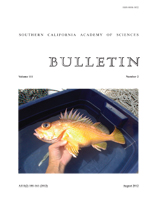One of the primary challenges to detecting anthropogenic environmental impacts is the high degree of spatial and temporal variability inherent in natural systems. Planned or routine events that result in disturbance to populations and communities provide an opportunity for scientists to apply well-replicated and statistically powerful sampling designs to assess subsequent biological effects. For example, a thick layer of sessile invertebrates is the prominent biotic feature of intertidal and shallow subtidal portions of offshore petroleum platforms in southern California. Given the central role of such invertebrates in providing food and shelter, their presence can reasonably be expected to influence associated fish community structure. At one platform on the San Pedro Shelf, invertebrate biomass was completely removed from support pilings and horizontal crossmembers to a depth of 20 m with high-pressure water during a standard “hydrocleaning” event in November 2007. Three nearby platforms remained undisturbed, providing a unique opportunity to test for disturbance-related changes in the local fish assemblage and the overall time course of community recovery. The potential impact of the abrupt and intense removal of the invertebrate layer was assessed with survey data collected periodically for one year prior- and one year post-hydrocleaning in a modified Before-After-Control-Impact (BACI) design. Asymmetrical multivariate analyses of variance revealed a significant effect of disturbance to fish, driven largely by reductions in the abundance of numerically dominant blacksmith (Chromis punctipinnis). Nevertheless, the system was surprisingly resilient, recovering to pre-disturbance conditions within ten months. Our results demonstrate that a well-replicated BACI sampling design can detect even subtle biological changes in response to disturbance, a key step towards developing a mechanistic understanding of community disassembly in the face of increasingly frequent and intense perturbations.
BioOne.org will be down briefly for maintenance on 17 December 2024 between 18:00-22:00 Pacific Time US. We apologize for any inconvenience.
Home
>
Journals
>
Bulletin, Southern California Academy of Sciences
>
Volume 111
>
Issue 2
>
Article
How to translate text using browser tools
1 August 2012
Environmental Impact Assessment: Detecting Changes in Fish Community Structure in Response to Disturbance with an Asymmetric Multivariate BACI Sampling Design
Christopher J.B. Martin,
Bengt J. Allen,
Christopher G. Lowe
ACCESS THE FULL ARTICLE





